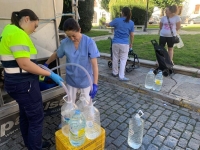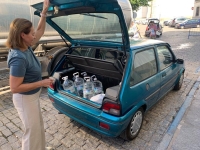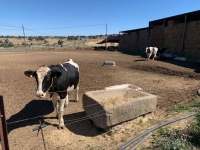It was 10 a.m. when the villagers, clutching empty plastic containers, lined up behind the tanker truck of drinking water. A cake shop owner arrived with four big jugs for his pastries. Workers from a retirement home carried two dozen bottles back on wheelchairs for their wards. And a mother of four loaded her trunk with fresh water to wash vegetables and cook pasta.
"This is a disgrace,” said Antonio Luque, the cake shop owner. "We can’t even wash dishes with tap water. It’s very murky.”
Spain has been blighted by a long-running drought, caused by record-high temperatures in 2022, a string of heat waves in 2023, and almost three years of reduced rainfall. Throughout the country, reservoirs have been depleted; in the worst-affected areas, they are at less than 20% of their capacity.
Human-caused global warming has made severe droughts such as those in Europe in recent years much more likely to occur, scientists have found.
But few places on the continent have been as badly hit as tiny Pozoblanco, a village of about 18,000 in southern Spain, where the daily struggle for drinkable water has become a glimpse of what may lie ahead for parts of Europe where drought and extreme heat have become increasingly common.
Pozoblanco and 22 other villages in this traditional pig and cattle farming area north of the city of Cordoba have needed deliveries of fresh water since April, when the Sierra Boyera reservoir, which supplies the area, dried up.
Attempts to alleviate the crisis backfired when the government channeled water from a backup reservoir, La Colada, which had been stagnant and used only for leisure pursuits such as fishing and kayaking since it was built 17 years ago.
It, too, was at a record low, meaning that what little water was left had greater contact with the sediments at its base, where waste from farms and villages accumulates.
A few days after the reservoir was connected to the villages in April, the water from La Colada was found to be contaminated. More than 18 tons of dead fish were cleared from the banks of La Colada by government officials in September.
"When there is drought, the concentration of contaminants is greater, and water reserves can become not just unfit for drinking, but poisonous,” Pedro Arrojo-Agudo, U.N. special rapporteur on safe drinking water and sanitation, said in an interview.
Since April, a fleet of tanker trucks has been deployed to deliver 180,000 liters of potable water a day to about 80,000 residents in the province. But the contaminated water is still used by many to bathe and for household chores.
Shana Dooley, 36, an English teacher in Pozoblanco, said she worried about the potential dangers. Both of her children, one of whom is prone to a bacterial infection called impetigo, have had skin rashes over the past few months. Dooley is also concerned that her younger child might be swallowing the water.
"It’s hard to know if the 3-year-old is drinking the water when he’s playing around in the shower,” she said.
Elena Lopez, 41, who lives around the corner from Dooley and is seven months pregnant, is considering using water from the well in her backyard — which she has so far used only to water her plants — if tests show it is clean enough.
It is not just drought that has left Pozoblanco and the surrounding towns and villages in such dire straits, says Maria Jose Polo, a professor of hydraulic engineering at the University of Cordoba.
The economic development of the province, where cattle farming either directly or indirectly employs 11,000 of the 80,000 residents, has led to greater water consumption than decades ago.
As well as the reservoir problems, groundwater and wells used by farmers for their cattle have become depleted, she said.
"What the province has lost in terms of precipitation over the last 50 years is less than the growth of the demand for water,” Polo noted.
If precipitation levels remain low this winter, the southernmost region of Spain, Andalusia, could lose 7% of its gross domestic product, according to local officials. Deeper into the future, studies have shown that 74% of Spain risks encroachment by deserts this century.
The want for water has sown despair all around.
Rafael Munoz, a livestock farmer, had to sell his Iberian pigs because the oak trees on his 2,000-acre farm have yielded no acorns this year to fatten them up.
"Extensive cattle grazing, which is a way of life here, is in danger of extinction,” Munoz said, adding that the drought was killing about 40 oak trees per couple of acres per year in the forests in this province, "which create the last European barrier with the Sahara Desert.”
On the other side of the village, Francisco Lopez, 50, who runs a dairy farm, has found his well running out of water, too — and each of his cows needs up to 200 liters of water a day.
To avoid catastrophe, Lopez has dipped into his savings, spending €7,000 (about $7,400) to find and gain access to another groundwater source on his land.
"I am thinking about giving this up,” he said, referring to the farm. "I’m not going to bankrupt myself maintaining it.”
In the village, bakery owner Pedro Fernandez, 64, says that managing the water shortage has become a job of its own for his staff of nine. Ice-cold water is a fundamental ingredient of bread dough, he explained, and every day one of his employees must collect 250 liters from the tankers.
"If there are long queues, he has to wait an hour,” Fernandez said. "We have to plan carefully. We can’t afford to run out of water, and we have to keep it at the right temperature.”
Many residents blame politicians for not acting sooner. On a recent evening, a group of neighbors who belong to a citizens platform called United for Water met to discuss their options.
In September, they organized a requiem for the "dead” Sierra Boyera reservoir. But they say that their complaints fall on deaf ears.
A supply of drinking water would be guaranteed, they say, had the depleted Sierra Boyera reservoir been connected to one of the larger — and fuller — reservoirs in the wider region.
"The regional politicians have been promising a connection for 30 years,” said Miguel Aparicio, president of United for Water.
But the project to connect the province to a strategic reserve of drinking water is a giant undertaking. If it were approved now, it would take at least two years to build, according to Polo, the hydraulic engineer.
The mayor of Pozoblanco, Santiago Cabello Munoz, acknowledges that lack of planning is why the water infrastructure has proved insufficient during the drought. Faced with the prospect of another dry fall, Cabello Munoz and other local officials are scrambling to reassure the population.
Plans to construct, within six months, a water treatment plant capable of purifying even the contaminated — and diminished — supply from La Colada are under discussion, although funding is yet to be approved.
Without rain, however, Polo said she was skeptical.
"In the short term, they’ve done what they had to do with the tanker trucks,” she said. "There’s not much else that can be done.”
This article originally appeared in The New York Times © 2025 The New York Times Company

























With your current subscription plan you can comment on stories. However, before writing your first comment, please create a display name in the Profile section of your subscriber account page.